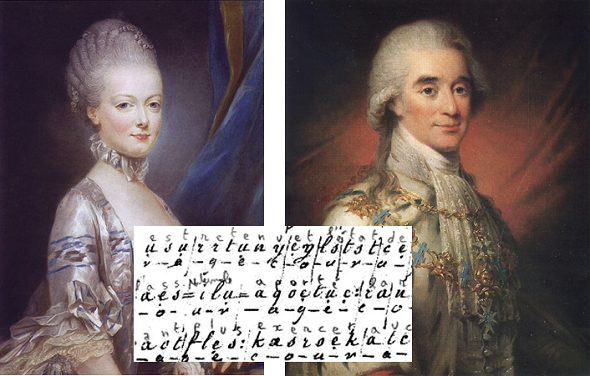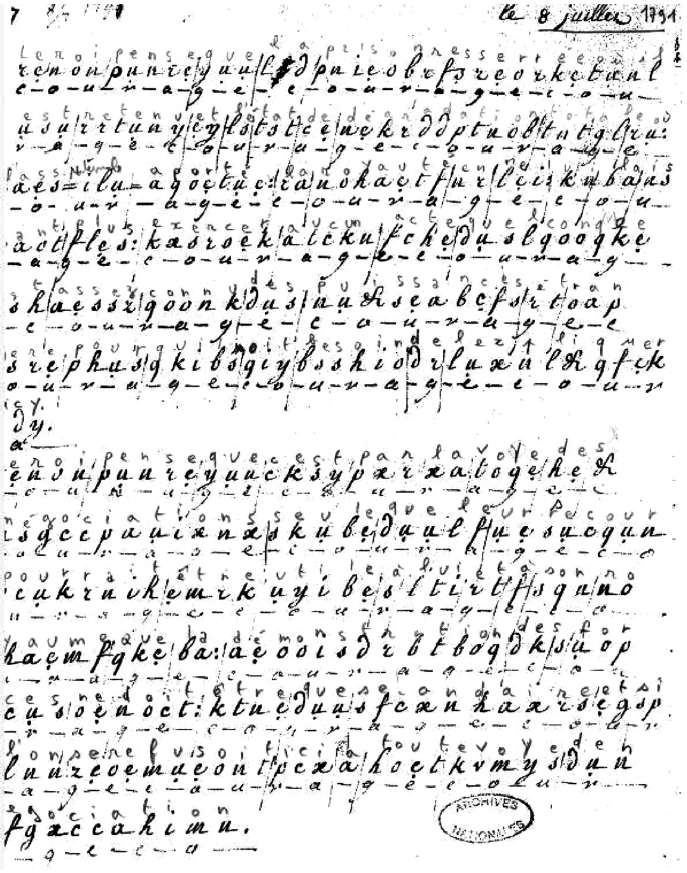During the French Revolution, Queen of France Marie-Antoinette sent a number of encrypted letters to Swedish diplomat Axel von Fersen. Two French scientists took a close look at them.
Marie-Antoinette (1755–1793) was a daughter of Austrian Queen Maria Theresia. In the age of 15, she was married to the French Dauphin and later became Queen of France. During the French Revolution, the royal family was placed under serious guard. Nevertheless, Marie-Antoinette succeeded in sending letters to Axel von Fersen, a Swedish diplomat living in Paris. Some of these letters were enciphered; others were plaintext or written with invisible ink.
Much of the content of these letters is political in nature, but some parts express Marie-Antoinette’s love for Fersen. According to her, the work of copying and enciphering was tedious. She complained about it: “Farewell, I am getting tired of ciphering; this is not my usual occupation and I am always afraid of making mistakes.” Unlike Mary Queen of Scots in the 16th century, Marie-Antoinette did not suffer from cryptanalysis of her letters.
A polyalphabetic system
In a Cryptologia article of 2010, French scientists Jaques Patarin and Valérie Nachef explained how Marie-Antoinette’s letters to Axel von Fersen were enciphered. The two used a polyalphabetic system. Such an algorithm was considered practically unbreakable at that time. The system needs two different keys: an enciphering table, which is fixed, and a keyword, which is different for each message. Here’s the enciphering table:
A AB CD EF GH IK LM NO PQ RS TU XY Z&
B AC BK DU EI FL GN HO MY PS QX RT Z&
C AD BG CZ EK FM HT IX LR NP OQ S& UY
D AE BZ CT DK FI GS HY LQ MX NR O& PU
E AF BL CI DH EU GK MT NQ OR P& SX YZ
F AH BF CL DG EQ IY KP MU NS O& RX TZ
G AG BI CL DN ER FP HT KU M& OX QY SZ
H AI BT CS DO EL F& GH KM NQ PR UY XZ
I AK BT CS DX EI FL GZ HY M& NP OQ RU
K AL BO CP DG ER FS HU IX KY MZ N& QT
L AM BZ CD EG FI HK LN OR PS QU TY X&
M AN BO CP DQ ER FS GT HU IX KY LZ M&
N AO BC DM EP FS GN HY IU KT LQ R& XZ
O AP BL CK DQ ES FU GX HZ I& MO NR TY
P AQ BX CU DZ ES FO GY HT IN KR L& MP
Q AR BZ CT DH EU FQ GO IL KN MP SY X&
R AS BN CQ DT EU FY G& HO IP KR LX MZ
S AT BP CQ DR E& FS GU HX IY KZ LN MO
T AU BY CM DX E& FH GQ IR KZ LS NP OT
U AX BL CO DQ ES FU GT HY IN KZ M& PR
X AY B& CZ DE FX GU HI KT LS MR NP OQ
Y AZ BU CG DH EX FY IO K& LN MP QS RT
The keyword is written under the cleartext as many times as needed. For example, if the keyword is HELLO and the cleartext is GREETINGS FROM THE KING, it looks like this:
GREETINGS FROM THE KING
HELLOHELL OHEL LOH ELLO
These two lines mean: To encrypt the first cleartext letter, G, we need to look at the table row starting with H; to encrypt the second cleartext letter, R, we need to look at the table row starting with E; to encrypt the third cleartext letter, E, we need to look at the table row starting with L; and so on.
In the respective table row we have to look for the chaaracter pair containing the cleartext letter. This is GH for G, OR for R, EG for E, EG for E, TY for T and so on. The ciphertext letter is always the other letter contained in the pair. GREETINGS FROM THE KING thus encrypts to:
HOGGYAQEP UPRA YZL GFLX
Two examples
In their Cryptologia publication, Jaques Patarin and Valérie Nachef present the following letter they decrypted with the keyword DEPUIS (since), translated to English:
Here is a large report I wrote on the ideas of the king. It is certain that force will do only damage. We have to give way to the storm. We would not have time to be rescued. Give this report toM. de Mercy in order that he takes care of it; the opinions of my brothers and those to whom it would be necessary to talk. I wish that you would not go to Vienna, that you stay near the king, and that you will be the least visible. In all of this, believe me, my gentle friend, I would like to owe you everything. I have strong reasons to make this request. Our happiness depends on it, since we would have no more happiness if we were separated forever. Farewell. Feel sorry for me. Love me. Above all do not judge me in all that you will see me doing before you hear me. I would die if I was for a moment disapproved by the one I adore, and I will never stop adoring him. The Lameth’s and their associates seem to want to serve us in good faith. I take advantage of this situation, but I trust them with caution. Farewell.
Here’s another one, it’s a love letter:
I can tell you that I love you and indeed that is all I have time for. I am well. Do not worry about me. I hope you to be well too. Write me cipher letters and send them by mail to Mrs. Brown’s address, in a double envelope to Mr. de Gougens. Send the letters by your manservant. Tell me to whom I should send the letters I could write you. I cannot live without that. Farewell, the most loved and the most loving of men. I kiss you with all my heart.
Open Questions
According to the Cryptologia publication, several questions are still open (the first one is especially interesting):
- How did Marie-Antoinette dissimulate the encoding table? Did she memorize it?
- Fersen and Marie-Antoinette used very simple words as keywords (depuis, vertu, autres, . . .) that changed with each letter. How did they agree on these keywords?
- Would it be possible in the future to read the crossed out passages of the letters?
- Would it be possible to find other encrypted letters?
If you have an answer, please let me know.
Follow @KlausSchmeh
Further reading: Who can break this enciphered letter written by Albrecht von Wallenstein?




Kommentare (1)